From Godzilla’s fiery atomic breath to post-apocalyptic anime and harrowing depictions of radiation sickness, the influence of the nuclear bombings of Hiroshima and Nagasaki runs deep in Japanese popular culture.
In the 80 years since the World War II attacks, stories of destruction and mutation have been fused with fears around natural disasters and, more recently, the Fukushima crisis.
Classic manga and anime series Astro Boy is called “Mighty Atom” in Japanese, while city-leveling explosions loom large in other titles such as Akira, Neon Genesis Evangelion and Attack on Titan.
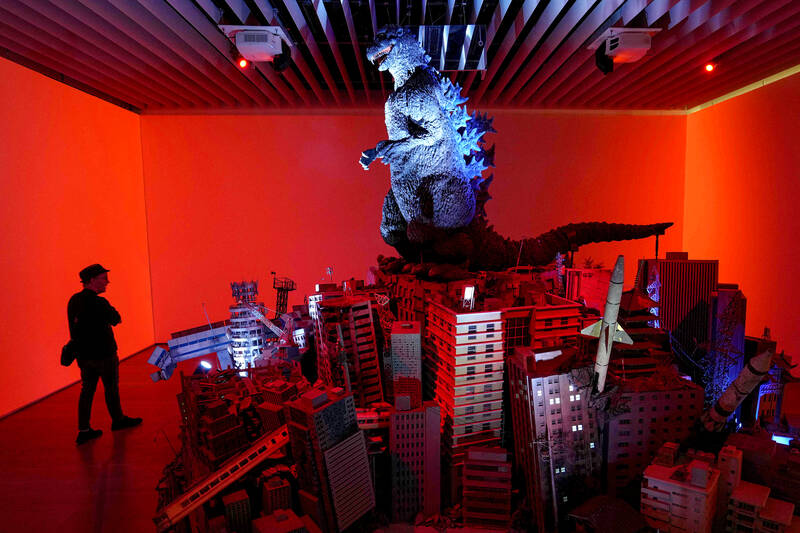
Photo: AFP
“Living through tremendous pain” and overcoming trauma is a recurrent theme in Japan’s cultural output “that global audiences have found fascinating,” said William Tsutsui, a history professor at Ottawa University.
The US nuclear bombing of Hiroshima on Aug. 6, 1945 left around 140,000 people dead. It was followed days later by the bombing of Nagasaki that killed around 74,000 people.
Some poetry “portrays the sheer terror of the atomic bomb at the moment it was dropped,” but many novels and artworks address the topic indirectly, said author Yoko Tawada.
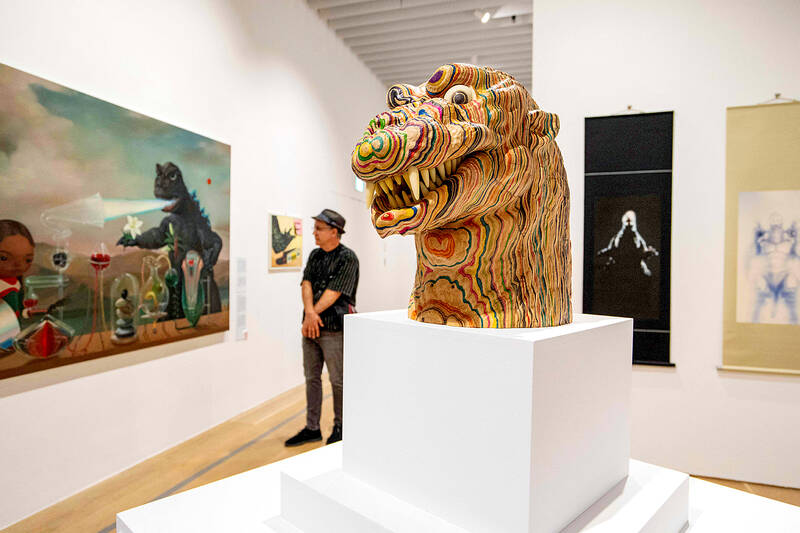
Photo: AFP
“It’s very difficult for the experience of the atomic bomb, which had never existed in history before, to find a place in the human heart as a memory,” she said.
Tawada’s 2014 book The Emissary focuses on the aftermath of an unspecified terrible event.
She was inspired by connections between the atomic bombs, the 2011 Fukushima nuclear disaster and “Minamata disease” — mass mercury poisoning caused by industrial pollution in southwest Japan from the 1950s.
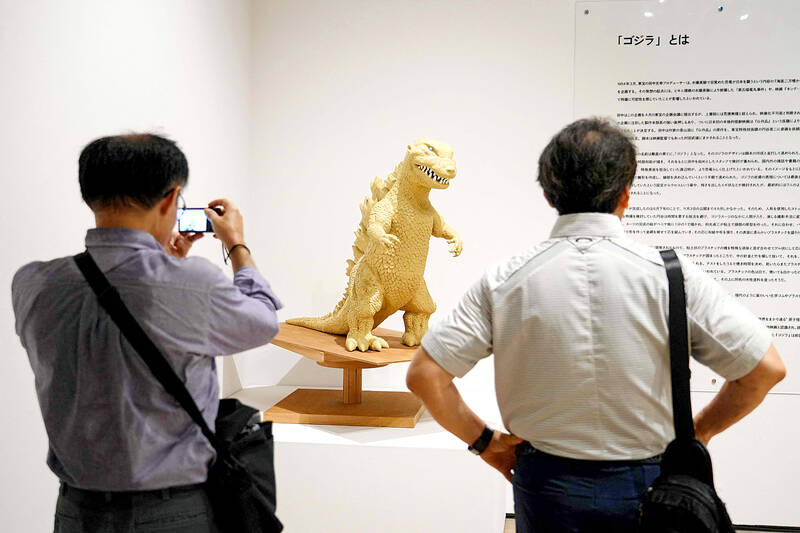
Photo: AFP
The story “is less of a warning, and more a message to say: things may get bad, but we’ll find a way to survive,” Tawada said.
GODZILLA’S SKIN
Narratives reflecting Japan’s complex relationship with nuclear technologies abound, but the most famous example is Godzilla, a prehistoric creature awakened by US hydrogen bomb testing in the Pacific.
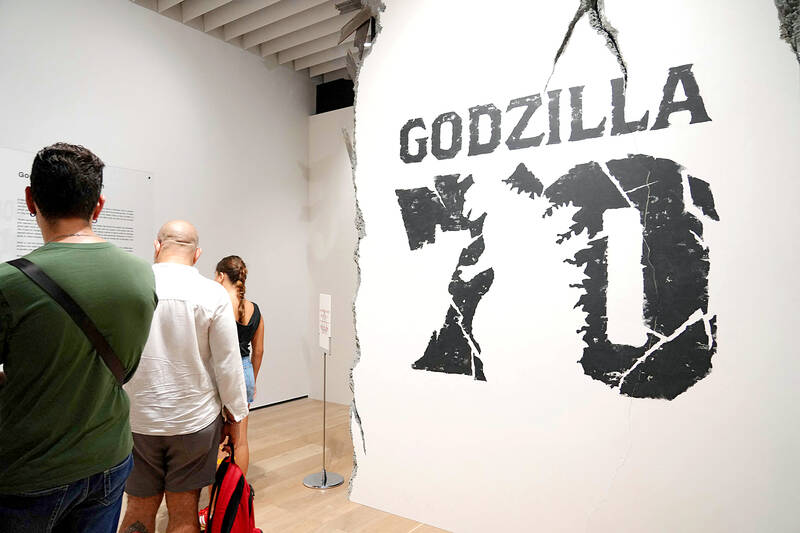
Photo: AFP
“We need monsters to give a face and form to abstract fears,” said professor Tsutsui, author of the book Godzilla on My Mind.
“In the 1950s, Godzilla fulfilled that role for the Japanese — with atomic energy, with radiation, with memories of the A-bombs.”
Many people who watched Godzilla rampage through Tokyo in the original 1954 film left theaters in tears, he said.
And “it’s said that the special effects people working on Godzilla modeled the monster’s heavily furrowed skin after the keloid scars on the survivors of Hiroshima and Nagasaki.”
In the nearly 40 Godzilla movies released since, nuclear themes are present but often given less prominence, partly to appease American audiences, Tsutsui said.
Even so, the series remains hugely popular, with 2016 megahit Shin Godzilla seen as a critique of Japan’s response to the tsunami-triggered Fukushima disaster.
‘BLACK RAIN’
Black Rain, a 1965 novel by Masuji Ibuse about radiation sickness and discrimination, is one of Japan’s best-known novels about the Hiroshima bombing.
But the fact Ibuse was not an A-bomb survivor is part of a “big debate about who is permitted to write these stories,” said Victoria Young of the University of Cambridge.
“How we talk about or create literature out of real life is always going to be difficult,” she said.
“Are you allowed to write about it if you didn’t directly experience it?”
Nobel-winning author Kenzaburo Oe collected survivor accounts in Hiroshima Notes, essays written on visits to the city in the 1960s.
“He’s confronting reality, but tries to approach it from a personal angle” including his relationship with his disabled son, said Tawada, who has lived in Germany for four decades after growing up in Japan.
“The anti-war education I received sometimes gave the impression that Japan was solely a victim” in World War II, she said.
“When it comes to the bombings, Japan was a victim — no doubt” but “it’s important to look at the bigger picture” including Japan’s wartime atrocities, she said.
As a child, illustrations of the nuclear bombings in contemporary picture books reminded her of depictions of hell in historical Japanese art.
This “made me consider whether human civilization itself harbored inherent dangers,” making atomic weapons feel less like “developments in technology, and more like something latent within humanity.”
See Korean on page 5
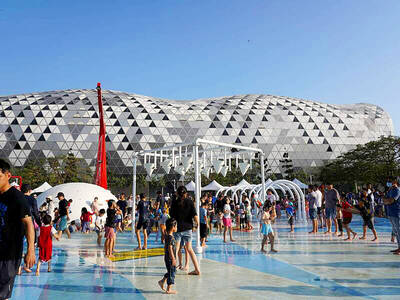
The Taipei Times last week reported that the rising share of seniors in the population is reshaping the nation’s housing markets. According to data from the Ministry of the Interior, about 850,000 residences were occupied by elderly people in the first quarter, including 655,000 that housed only one resident. H&B Realty chief researcher Jessica Hsu (徐佳馨), quoted in the article, said that there is rising demand for elderly-friendly housing, including units with elevators, barrier-free layouts and proximity to healthcare services. Hsu and others cited in the article highlighted the changing family residential dynamics, as children no longer live with parents,

It is jarring how differently Taiwan’s politics is portrayed in the international press compared to the local Chinese-language press. Viewed from abroad, Taiwan is seen as a geopolitical hotspot, or “The Most Dangerous Place on Earth,” as the Economist once blazoned across their cover. Meanwhile, tasked with facing down those existential threats, Taiwan’s leaders are dying their hair pink. These include former president Tsai Ing-wen (蔡英文), Vice President Hsiao Bi-khim (蕭美琴) and Kaohsiung Mayor Chen Chi-mai (陳其邁), among others. They are demonstrating what big fans they are of South Korean K-pop sensations Blackpink ahead of their concerts this weekend in Kaohsiung.

Oct 20 to Oct 26 After a day of fighting, the Japanese Army’s Second Division was resting when a curious delegation of two Scotsmen and 19 Taiwanese approached their camp. It was Oct. 20, 1895, and the troops had reached Taiye Village (太爺庄) in today’s Hunei District (湖內), Kaohsiung, just 10km away from their final target of Tainan. Led by Presbyterian missionaries Thomas Barclay and Duncan Ferguson, the group informed the Japanese that resistance leader Liu Yung-fu (劉永福) had fled to China the previous night, leaving his Black Flag Army fighters behind and the city in chaos. On behalf of the

I was 10 when I read an article in the local paper about the Air Guitar World Championships, which take place every year in my home town of Oulu, Finland. My parents had helped out at the very first contest back in 1996 — my mum gave out fliers, my dad sorted the music. Since then, national championships have been held all across the world, with the winners assembling in Oulu every summer. At the time, I asked my parents if I could compete. At first they were hesitant; the event was in a bar, and there would be a lot